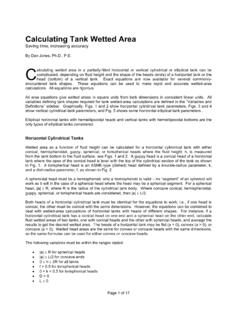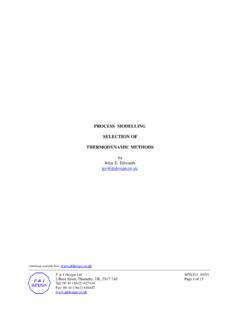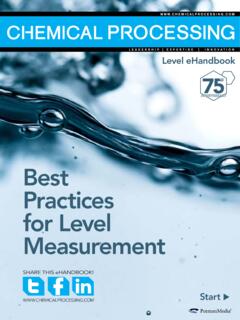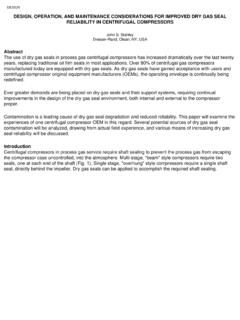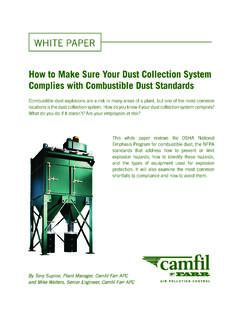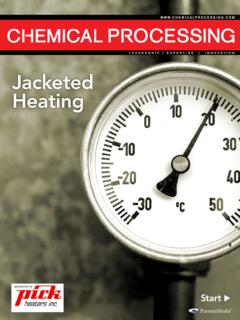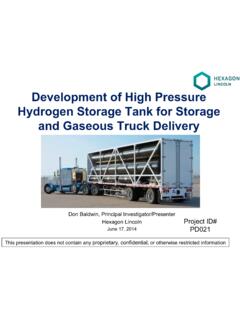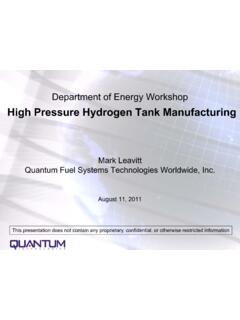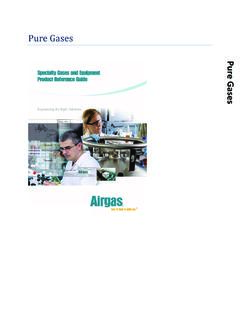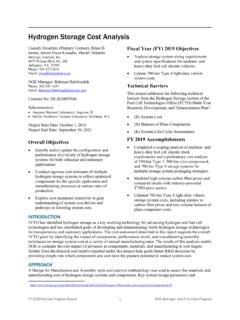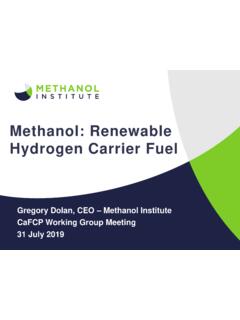Transcription of Nitrogen blanketing to keep your product intact and your …
1 Nitrogen blanketing to keep your product intact and your employees and equipment safe Inerting and blanketing can help you improve process safety and product quality, as well as lengthen your equipment life all while minimizing costs. Brought to you by Air Products. Over 75 years of gas-based innovations. Content Introduction 2. Overview 3. Benefits Safety Benefits 4. Flammability Limits 5. Improper Handling of Flammable or Combustible Materials 6. Quality Benefits 7. Implementing a blanketing System Types of tanks 8. Nitrogen Control Methods Continuous Purge 9 N2. pressure Control 10 12. Concentration Control 13 Due to its purity and inert Nitrogen Supply properties, Nitrogen can be used Delivery 14. when handling flammable or Purity 15. toxic materials, dealing with other Usage Patterns 16.
2 Fire and explosion hazards such Conclusion 17. as combustible dust, or ensuring Appendix 18 19. product quality in a sensitive material to improve safety and product quality. This content was first published by AIChE in Chemical Engineering Progress, November 2011. 1 | Contents Introduction Nitrogen is used for a variety of applications including purging, pressure transferring, inerting and blanketing . Nitrogen blanketing is the process of applying the gas to the vapor space of a container to control its composition. The benefits of Nitrogen blanketing include improved process safety, better product quality, and longer equipment life cycle. Nitrogen blanketing can be applied to a wide variety of container sizes ranging from a storage tank with a volume of millions of gallons down to a quart-size container or smaller.
3 Nitrogen blanketing , while widely used in the chemical, pharmaceutical, food processing and refining industries, is often overlooked as a way to improve safety, productivity and quality. Although blanketing is a simple plant practice, there are options for improvements that balance achieving desired safety or quality results with minimizing cost. Poor choices may add cost, waste Nitrogen or increase plant emissions. The following pages will share the practice of Nitrogen blanketing and explain how to make the application more effective and efficient. 2 | Introduction Overview Nitrogen blanketing helps protect personnel, products and assets by reducing the oxygen content in the vapor space of a storage tank or process vessel, making it inert and eliminating the possibility of fire or explosion.
4 It also decreases evaporation and protects the tank from structural corrosion damage caused by air and moisture. In addition, Nitrogen blanketing is used to prevent air, moisture or other contaminants from entering the vapor space, causing product degradation or spoilage. It is widely used for flammable or combustible materials, air/moisture Nitrogen is the most widely used gas for sensitive products, combustible dusts, food products such as edible oils, blanketing due to its inert properties, and purified water. In the refinery, chemical, food and pharmaceutical wide availability and relatively low processing industries, blanketing strategies are implemented during cost at any economic efficiency. production, storage, transportation and final packaging.
5 blanketing is also Other gases, such as carbon dioxide a common practice in shipping, aerospace and other industries where or argon, are also occasionally flammable materials are used or generated. It can be applied to tanks or used for certain applications. spaces on land, sea (shipboard) or air. 3 | Overview Safety Benefits In industries where combustible, flammable or explosive materials are processed, stored or generated, tank blanketing provides the greatest benefit safety. Tank blanketing is used to shield these types of products from coming into contact with the oxygen in air, thus creating a non- flammable environment that prevents fire and explosion. A fire requires three elements: an ignition source, fuel and oxygen. Removing any one of these three elements eliminates the possibility of fire.
6 The headspace of a storage tank contains a mixture of air and the vapor of the flammable material being stored, for example, a solvent. The mixture of solvent vapor and air may ignite and burn if the vapor mixture is within ) 2. (O. He the solvent's flammability limits and an ignition source is present. This can en at lead to tragic consequences such as severe injury to people and property yg Ox damage. Although storage tank facilities may be electrically grounded to Fire reduce the probability of ignition, static charges can develop within the system or within the solvent itself, creating a source of ignition. Since it Combustible material (dust) or fuel is practically impossible to completely eliminate sources of static charge, and the fuel cannot be eliminated because it is the material being stored, oxygen is the only leg of the fire triangle that can be controlled.
7 The fire triangle depicts the three elements needed for a fire: fuel, oxygen, and an ignition source. 4 | Safety Benefits Flammability Limits A storage tank can be made inert by: Flammability Diagram 1) reducing the oxygen content of the vapor space This diagram presents the flammability envelope for an example material (hydrogen in air in to a value that is less than the concentration that this case). Notice that beyond the LOC (Limiting Oxygen Concentration), combustion cannot take place. will support combustion (known as the Limiting Oxygen Concentration (LOC)); 90. UEL in air: 75%. 2) reducing the fuel concentration in the 80. vapor space to a value less than the minimum concentration (Lower Explosion Limit (LEL) or 70. Lower Flammability Limit) that can support combustion; or 60.
8 3) increasing the fuel concentration in the vapor % Fuel in N2/O2 mix space to a value greater than the maximum Nose or LOC. 50. concentration (Upper Explosion Limit (UEL) or FLAMMABILITY. Upper Flammability Limit) that can support ENVELOPE. 40. combustion as shown in the figure on the right. 30. The LEL and UEL for a given material can be found in the manufacturer's Material Safety 20. Data Sheet (MSDS). Tabulated LOC values for many chemicals (see examples in Appendix 1). 10. can be found in chemical industry handbooks and guides such as the National Fire Protection Association (NFPA) Guide # The flammable 21% 14% 7% 0%. limits of mixtures of gases, fuels and inerts at LEL in air: elevated temperatures and pressures can be % O2 in N2. determined by computational methods.
9 5 | Flammability Limits Improper Handling of Flammable or Combustible Materials The safety implications of improper handling of flammable or combustible materials are severe. Yet at some manufacturing plants, there is a false sense of security and general belief that it can't happen here.. Consequently, inerting and blanketing are often overlooked in safety reviews or during maintenance turnarounds or upgrade projects. Lack of blanketing or inadequate blanketing of flammable products has resulted in serious fires and explosions. In one incident, explosions and fire erupted at the Barton Solvents facility in Valley Center, Kansas, on July 17, 2007. The accident led to the evacuation of thousands of residents and resulted in projectile damage offsite, as well as extensive damage to the facility.
10 The Chemical Safety Board undertook a thorough investigation2 to identify the root cause and recommend preventive actions. The key findings were that a non-conductive flammable liquid accumulated static electricity during transfer and storage, and static sparks ignited flammable vapor-air mixtures inside the storage tanks . An important recommendation from the investigation was to add an inert gas to the tank to reduce the concentration of oxygen in the headspace. 6 | Improper Handling of Flammable or Combustible Materials Quality Benefits Some sensitive materials, especially in the food, pharmaceutical or nutraceutical industries, may experience degradation of product quality when contacted with oxygen, moisture or other contaminants. blanketing creates a slight positive pressure inside storage containers, which prevents air and other contaminants from infiltrating and causing oxidative degradation and spoilage.
